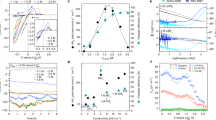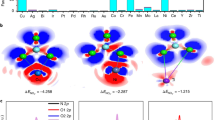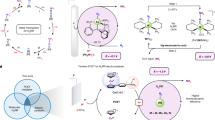Abstract
Ammonia plays a substantial role in agriculture and the next generation of carbon-free energy supply. Electrocatalytic nitrate reduction to NH3 is attractive for nitrate removal and NH3 production under ambient conditions. However, the energy efficiency is limited by the high reaction overpotential. Here we propose a three-step relay mechanism composed of a spontaneous redox reaction, electrochemical reduction and electrocatalytic reduction to overcome this issue. RuxCoy alloys were designed and adopted as model catalysts. Ru15Co85 exhibits an onset potential of +0.4 V versus reversible hydrogen electrode, and an energy efficiency of 42 ± 2%. The high performance results in a low production cost of US$0.49 ± 0.02 per kilogram of ammonia. The high nitrate reduction performances on Ru15Fe85 and Ru15Ni85 also highlight the promising potential of the relay mechanism.

This is a preview of subscription content, access via your institution
Access options
Access Nature and 54 other Nature Portfolio journals
Get Nature+, our best-value online-access subscription
$29.99 / 30 days
cancel any time
Subscribe to this journal
Receive 12 digital issues and online access to articles
$119.00 per year
only $9.92 per issue
Buy this article
- Purchase on Springer Link
- Instant access to full article PDF
Prices may be subject to local taxes which are calculated during checkout






Similar content being viewed by others
Data availability
Data are available from the corresponding authors upon reasonable request. Source data are provided with this paper.
References
Van Langevelde, P. H., Katsounaros, I. & Koper, M. T. Electrocatalytic nitrate reduction for sustainable ammonia production. Joule 5, 290–294 (2021).
Christensen, C. H., Johannessen, T., Sørensen, R. Z. & Nørskov, J. K. Towards an ammonia-mediated hydrogen economy? Catal. Today 111, 140–144 (2006).
Van der Ham, C. J., Koper, M. T. & Hetterscheid, D. G. Challenges in reduction of dinitrogen by proton and electron transfer. Chem. Soc. Rev. 43, 5183–5191 (2014).
Rogan, W. J. & Brady, M. T. Drinking water from private wells and risks to children. Pediatrics 123, e1123–e1137 (2009).
Li, L. et al. Efficient nitrogen fixation to ammonia through integration of plasma oxidation with electrocatalytic reduction. Angew. Chem. Int. Ed. 60, 14131–14137 (2021).
Sun, J. et al. A hybrid plasma electrocatalytic process for sustainable ammonia production. Energy Environ. Sci. 14, 865–872 (2021).
Yuan, S. et al. Nitrate formation from atmospheric nitrogen and oxygen photocatalysed by nano-sized titanium dioxide. Nat. Commun. 4, 2249 (2013).
Wang, Y., Yu, Y., Jia, R., Zhang, C. & Zhang, B. Electrochemical synthesis of nitric acid from air and ammonia through waste utilization. Natl. Sci. Rev 6, 730–738 (2019).
Chen, F. et al. Efficient conversion of low-concentration nitrate sources into ammonia on a Ru-dispersed Cu nanowire electrocatalyst. Nat. Nanotechnol. 17, 759–767 (2022).
Chen, G. et al. Electrochemical reduction of nitrate to ammonia via direct eight-electron transfer using a copper–molecular solid catalyst. Nat. Energy 5, 605–613 (2020).
Wang, A. et al. Electrochemistry-stimulated environmental bioremediation: development of applicable modular electrode and system scale-up. Environ. Sci. Ecotechnol. 3, 100050 (2020).
Zheng, W. et al. Self-activated Ni cathode for electrocatalytic nitrate reduction to ammonia: from fundamentals to scale-up for treatment of industrial wastewater. Environ. Sci. Technol. 55, 13231–13243 (2021).
Wang, Y. et al. Enhanced nitrate-to-ammonia activity on copper-nickel alloys via tuning of intermediate adsorption. J. Am. Chem. Soc. 142, 5702–5708 (2020).
Li, J. et al. Efficient ammonia electrosynthesis from nitrate on strained ruthenium nanoclusters. J. Am. Chem. Soc. 142, 7036–7046 (2020).
Dima, G. E., de Vooys, A. C. A. & Koper, M. T. M. Electrocatalytic reduction of nitrate at low concentration on coinage and transition-metal electrodes in acid solutions. J. Electroanal. Chem. 554−555, 15–23 (2003).
Gatla, S. et al. Impact of Co-components on the state of Pd and the performance of supported Pd/TiO2 catalysts in the gas-phase acetoxylation of toluene. ChemCatChem 3, 1893–1901 (2011).
Nørskov, J. K. et al. Trends in the exchange current for hydrogen evolution. J. Electrochem. Soc. 152, J23 (2005).
Seh, Z. W. et al. Combining theory and experiment in electrocatalysis: insights into materials design. Science 355, eaad4998 (2017).
Jaramillo, T. F. et al. Identification of active edge sites for electrochemical H2 evolution from MoS2 nanocatalysts. Science 317, 100–102 (2007).
Miao, M. et al. Molybdenum carbide-based electrocatalysts for hydrogen evolution reaction. Chem. Eur. J. 23, 10947–10961 (2017).
Hoster, H. E. Anodic hydrogen oxidation at bare and Pt-modified Ru(0001) in flowing electrolyte-theory versus experiment. MRS Online Proc. Library 1388, 10 (2012).
Tian, X. et al. Engineering bunched Pt-Ni alloy nanocages for efficient oxygen reduction in practical fuel cells. Science 366, 850–856 (2019).
Yu, Y., Shi, Y. & Zhang, B. Synergetic transformation of solid inorganic-organic hybrids into advanced nanomaterials for catalytic water splitting. Acc. Chem. Res. 51, 1711–1721 (2018).
Chee, S. W., Tan, S. F., Baraissov, Z., Bosman, M. & Mirsaidov, U. Direct observation of the nanoscale Kirkendall effect during galvanic replacement reactions. Nat. Commun. 8, 1224 (2017).
Liu, Z. et al. Tuning infrared plasmon resonances in doped metal-oxide nanocrystals through cation-exchange reactions. Nat. Commun. 10, 1394 (2019).
Zhu, T. et al. High-index faceted RuCo nanoscrews for water electrosplitting. Adv. Energy Mater. 10, 2002860 (2020).
He, T. et al. Mastering the surface strain of platinum catalysts for efficient electrocatalysis. Nature 598, 76–81 (2021).
Zhuang, Z. et al. Three-dimensional open nano-netcage electrocatalysts for efficient pH-universal overall water splitting. Nat. Commun. 10, 4875 (2019).
Biesinger, M. C. et al. Resolving surface chemical states in XPS analysis of first row transition metals, oxides and hydroxides: Cr, Mn, Fe, Co and Ni. Appl. Surf. Sci. 257, 2717–2730 (2011).
Niu, S., Li, S., Du, Y., Han, X. & Xu, P. How to reliably report the overpotential of an electrocatalyst. ACS Energy Lett. 5, 1083–1087 (2020).
Hodgetts, R. Y. et al. Refining universal procedures for ammonium quantification via rapid 1H NMR analysis for dinitrogen reduction studies. ACS Energy Lett. 5, 736–741 (2020).
Xia, C. et al. Confined local oxygen gas promotes electrochemical water oxidation to hydrogen peroxide. Nat. Catal. 3, 125–134 (2020).
MacFarlane, D. R. et al. A roadmap to the ammonia economy. Joule 4, 1186–1205 (2020).
Wang, Y., Zhou, W., Jia, R., Yu, Y. & Zhang, B. Unveiling the activity origin of a copper-based electrocatalyst for selective nitrate reduction to ammonia. Angew. Chem. Int. Ed. 59, 5350–5354 (2020).
Wang, Z., Young, S. D., Goldsmith, B. R. & Singh, N. Increasing electrocatalytic nitrate reduction activity by controlling adsorption through PtRu alloying. J. Catal. 395, 143–154 (2021).
Liu, H. et al. Efficient electrochemical nitrate reduction to ammonia with copper-supported rhodium cluster and single-atom catalysts. Angew. Chem. Int. Ed. 61, e202202556 (2022).
Zhou, Y. et al. Lattice-confined Ru clusters with high CO tolerance and activity for the hydrogen oxidation reaction. Nat. Catal. 3, 454–462 (2020).
Koper, M. T. M. Theory of multiple proton-electron transfer reactions and its implications for electrocatalysis. Chem. Sci. 4, 2710–2723 (2013).
Yao, Y., Zhu, S., Wang, H., Li, H. & Shao, M. A spectroscopic study on the nitrogen electrochemical reduction reaction on gold and platinum surfaces. J. Am. Chem. Soc. 140, 1496–1501 (2018).
Katsounaros, I. et al. On the mechanism of the electrochemical conversion of ammonia to dinitrogen on Pt (100) in alkaline environment. J. Catal. 359, 82–91 (2018).
Liu, H. et al. Low-coordination rhodium catalysts for an efficient electrochemical nitrate reduction to ammonia. ACS Catal. 13, 1513–1521 (2023).
Fanning, J. C. The chemical reduction of nitrate in aqueous solution. Coord. Chem. Rev. 199, 159–179 (2000).
Yang, J. et al. Hollow Zn/Co ZIF particles derived from core-shell ZIF-67@ZIF-8 as selective catalyst for the semi-hydrogenation of acetylene. Angew. Chem. Int. Ed. 54, 10889–10893 (2015).
Tufts, B. J. et al. XPS and EXAFS studies of the reactions of cobalt (III) ammine complexes with gallium arsenide surfaces. J. Am. Chem. Soc. 112, 5123–5136 (1990).
McCrory, C. C., Jung, S., Peters, J. C. & Jaramillo, T. F. Benchmarking heterogeneous electrocatalysts for the oxygen evolution reaction. J. Am. Chem. Soc. 135, 16977–16987 (2013).
Wu, J. et al. Densely populated isolated single Co-N site for efficient oxygen electrocatalysis. Adv. Energy Mater. 9, 1900149 (2019).
McCrory, C. C. et al. Benchmarking hydrogen evolving reaction and oxygen evolving reaction electrocatalysts for solar water splitting devices. J. Am. Chem. Soc. 137, 4347–4357 (2015).
Wang, J. et al. Redirecting dynamic surface restructuring of a layered transition metal oxide catalyst for superior water oxidation. Nat. Catal. 4, 212–222 (2021).
Calle-Vallejo, F., Huang, M., Henry, J. B., Koper, M. T. & Bandarenka, A. S. Theoretical design and experimental implementation of Ag/Au electrodes for the electrochemical reduction of nitrate. Phys. Chem. Chem. Phys. 15, 3196–3202 (2013).
Henkelman, G., Uberuaga, B. P. & Jónsson, H. A climbing image nudged elastic band method for finding saddle points and minimum energy paths. J. Chem. Phys. 113, 9901–9904 (2000).
Acknowledgements
We acknowledge support from the National Natural Science Foundation of China (grants nos. 22071173 (Y.Y.), 22271213 (B.Z.) and 21871206 (B.Z.)) and the Natural Science Foundation of Tianjin City (no. 20JCJQJC00050 (Y.Y.)). We thank the Haihe Laboratory of Sustainable Chemical Transformations for financial support. We thank Y. Liu in the Analysis and Testing Center at Tianjin University for in situ ATR-FTIR assistance and L. Zheng at the 1W1B beamline of the Beijing Synchrotron Radiation Facility for supporting this work.
Author information
Authors and Affiliations
Contributions
B.Z. and Y.Y. conceived the idea and supervised the project. B.Z., Y.Y. and S.H. designed the experiments. S.H. synthesized the materials and carried out electrochemical measurements. H.L. and R.Y. performed theoretical calculations. S.H. and T.L. carried out in situ experiments. S.H. and F.C. drew the schematic diagram. B.Z., Y.Y., H.L., and S.H. wrote the paper, with comments from all authors.
Corresponding authors
Ethics declarations
Competing interests
The authors declare no competing interests.
Peer review
Peer review information
Nature Catalysis thanks the anonymous reviewers for their contribution to the peer review of this work.
Additional information
Publisher’s note Springer Nature remains neutral with regard to jurisdictional claims in published maps and institutional affiliations.
Supplementary information
Supplementary Information
Supplementary Figs. 1–39, notes 1–8 and Tables 1–8.
Supplementary Data
Source Date of DFT
Source data
Source Data Fig. 1
Catalyst design for the NO3−RR
Source Data Fig. 2
Structural characterization of RuxCoyOz and RuxCoy HNDs
Source Data Fig. 3
Electrocatalytic performance for the NO3−RR
Source Data Fig. 4
Mechanistic studies for NO3−RR over Ru15Co85 HNDs
Source Data Fig. 5
NO3−RR pathway over Ru15Co85 HNDs
Source Data Fig. 6
Theoretical calculation results for NO3−RR
Rights and permissions
Springer Nature or its licensor (e.g. a society or other partner) holds exclusive rights to this article under a publishing agreement with the author(s) or other rightsholder(s); author self-archiving of the accepted manuscript version of this article is solely governed by the terms of such publishing agreement and applicable law.
About this article
Cite this article
Han, S., Li, H., Li, T. et al. Ultralow overpotential nitrate reduction to ammonia via a three-step relay mechanism. Nat Catal 6, 402–414 (2023). https://doi.org/10.1038/s41929-023-00951-2
Received:
Accepted:
Published:
Issue Date:
DOI: https://doi.org/10.1038/s41929-023-00951-2
This article is cited by
-
Atomic reconstruction for realizing stable solar-driven reversible hydrogen storage of magnesium hydride
Nature Communications (2024)
-
Sustainable conversion of alkaline nitrate to ammonia at activities greater than 2 A cm−2
Nature Communications (2024)
-
Efficient conversion of propane in a microchannel reactor at ambient conditions
Nature Communications (2024)
-
Electrochemical hydrogenation and oxidation of organic species involving water
Nature Reviews Chemistry (2024)
-
Defect-induced triple synergistic modulation in copper for superior electrochemical ammonia production across broad nitrate concentrations
Nature Communications (2024)



